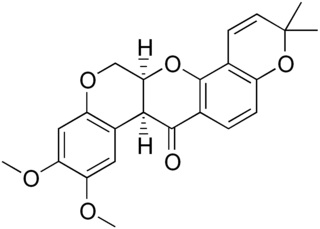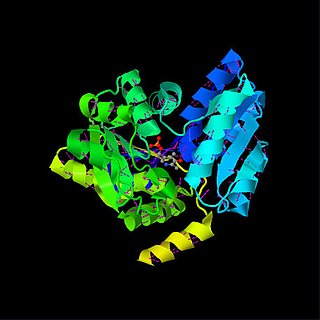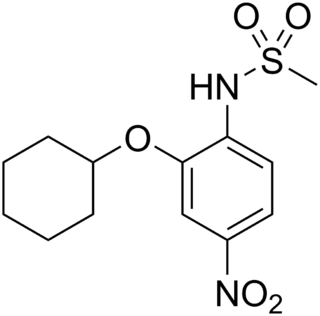
Lovastatin, sold under the brand name Mevacor among others, is a statin medication, to treat high blood cholesterol and reduce the risk of cardiovascular disease. Its use is recommended together with lifestyle changes. It is taken by mouth.

2-Methoxyestradiol is a natural metabolite of estradiol and 2-hydroxyestradiol (2-OHE2). It is specifically the 2-methyl ether of 2-hydroxyestradiol. 2-Methoxyestradiol prevents the formation of new blood vessels that tumors need in order to grow (angiogenesis), hence it is an angiogenesis inhibitor. It also acts as a vasodilator and induces apoptosis in some cancer cell lines. 2-Methoxyestradiol is derived from estradiol, although it interacts poorly with the estrogen receptors. However, it retains activity as a high-affinity agonist of the G protein-coupled estrogen receptor (GPER).
Glucuronidation is often involved in drug metabolism of substances such as drugs, pollutants, bilirubin, androgens, estrogens, mineralocorticoids, glucocorticoids, fatty acid derivatives, retinoids, and bile acids. These linkages involve glycosidic bonds.

Iproniazid is a non-selective, irreversible monoamine oxidase inhibitor (MAOI) of the hydrazine class. It is a xenobiotic that was originally designed to treat tuberculosis, but was later most prominently used as an antidepressant drug. However, it was withdrawn from the market because of its hepatotoxicity. The medical use of iproniazid was discontinued in most of the world in the 1960s, but remained in use in France until its discontinuation in 2015.

Deguelin is a derivative of rotenone. Both are compounds classified as rotenoids of the flavonoid family and are naturally occurring insecticides. They can be produced by extraction from several plant species belonging to three genera of the legume family, Fabaceae: Lonchocarpus, Derris, or Tephrosia.

Serine dehydratase or L-serine ammonia lyase (SDH) is in the β-family of pyridoxal phosphate-dependent (PLP) enzymes. SDH is found widely in nature, but its structure and properties vary among species. SDH is found in yeast, bacteria, and the cytoplasm of mammalian hepatocytes. SDH catalyzes the deamination of L-serine to yield pyruvate, with the release of ammonia.
AFPep is an orally-active, cyclic, 9-amino acid, peptide with a molecular weight of 969 daltons and is derived from the anti-oncogenic active site of alpha fetoprotein (AFP). Using the standard amino acid abbreviations, AFPep has the sequence cyclo(EKTOVNOGN), where O is hydroxyproline. This peptide has been shown in experimental animal models to be efficacious in the prevention and treatment of ER+ breast cancer.

Camostat is a serine protease inhibitor. Serine protease enzymes have a variety of functions in the body, and so camostat has a diverse range of uses. Camostat is approved in Japan for the treatment of chronic pancreatitis and postoperative reflux esophagitis. The oral proteolytic enzyme inhibitor has been on the market since 1985 under the trade name Foipan Tablets. The manufacturer is Ono Pharmaceutical. The drug is used in the treatment of some forms of cancer and is also effective against some viral infections, as well as inhibiting fibrosis in liver or kidney disease or pancreatitis.

β-Naphthoflavone, also known as 5,6-benzoflavone, is a potent agonist of the aryl hydrocarbon receptor and as such is an inducer of such detoxification enzymes as cytochromes P450 (CYPs) and uridine 5'-diphospho-glucuronosyltransferases (UGTs). β-Naphthoflavone is a putative chemopreventive agent.

Tametraline (CP-24,441) is the parent of a series of chemical compounds investigated at Pfizer that eventually led to the development of sertraline (CP-51,974-1).

Taxifolin (5,7,3',4'-flavan-on-ol), also known as dihydroquercetin, belongs to the subclass flavanonols in the flavonoids, which in turn is a class of polyphenols. It is extracted from plants such as Siberian larch and milk thistle.

NS-398 is a COX-2 inhibitor used in the study of the function of cyclooxygenases.

Dextrallorphan (DXA) is a chemical of the morphinan class that is used in scientific research. It acts as a σ1 receptor agonist and NMDA receptor antagonist. It has no significant affinity for the σ2, μ-opioid, or δ-opioid receptor, or for the serotonin or norepinephrine transporter. As an NMDA receptor antagonist, in vivo, it is approximately twice as potent as dextromethorphan, and five-fold less potent than dextrorphan.

Pedunculagin is an ellagitannin. It is formed from casuarictin via the loss of a gallate group.

Plomestane is a steroidal, irreversible aromatase inhibitor which was under development by Marion Merrell Dow/Hoechst Marion Russell as an antineoplastic agent for the treatment of breast cancer. It was found to be effective in preclinical studies and was also found to produce few adverse effects in human clinical trials, significantly reducing estrogen levels with a single administration. However, development of the drug for clinical use was halted due to "technical issues" and it was never marketed.

d-Fructose-l-histidine (FruHis) is a ketosamine combining the d-isomer of fructose and the l-isomer of histidine into a functional group. FruHis is present in dried fruits. In interaction with lycopene, FruHis is a potential food related antioxidant and chemopreventive agent, found abundantly in dried tomatoes.
Etomoxir, or rac-Ethyl 2-[6-(4-chlorophenoxy)hexyl]oxirane-2-carboxylate, in form of the dextrorotatory (R)-(+)- enantiomer, is an irreversible inhibitor of carnitine palmitoyltransferase-1 on the inner face of the outer mitochondrial membrane. The actual inhibitor – (R)-(+)-etomoxir-Coenzym A ester – is formed in an intracellular process. The middle inhibitor concentration for the inhibition of the CPT-1 in the liver, heart, and muscle mitochondria of rats lies in between 5 and 20 nmol/l, depending on the animal's state of metabolism. (+)-Etomoxir is a colourness solid with a melting point of 38 °C (311 K). The sodium salt of (+)-Etomoxir is water-soluble. The (S)-(-)-enantiomer of Etomoxir does not block CPT-1.

Metapristone is the major metabolite of mifepristone and a selective progesterone receptor modulator (SPRM) which itself was never marketed. It is formed from mifepristone in the liver by the enzyme CYP3A4 via monodemethylation, and circulates at concentrations higher than those of mifepristone. The metabolite retains partial but considerable affinity for the progesterone receptor (PR) and the glucocorticoid receptor (GR). On the basis of actions that are apparently independent of its hormonal activity, metapristone is being researched as a potential cancer metastatic chemopreventive agent.
Modeccin is a toxic lectin, a group of glycoproteins capable of binding specifically to sugar moieties. Different toxic lectins are present in seeds of different origin. Modeccin is found in the roots of the African plant Adenia digitata. These roots are often mistaken for edible roots, which has led to some cases of intoxication. Sometimes the fruit is eaten, or a root extract is drunk as a manner of suicide.
Broad-spectrum antivirals (BSAs) are a class of molecules or compounds, which inhibit the infection of multiple viruses from the same or different virus families. BSAs could be divided into experimental and investigational agents, and approved drugs. BSAs work by inhibiting viral proteins or by targeting host cell factors and processes exploited by different viruses during infection. As of 2021, there are 150 known BSAs in varying stages of development, effective against 78 human viruses. BSAs are potential candidates for treatment of emerging and re-emerging viruses, such as ebola, marburg, and SARS-CoV-2. Many BSAs show antiviral activity against other viruses than originally investigated. Efforts in drug repurposing for SARS-CoV-2 is currently underway. A database of BSAs and viruses they inhibit could be found here.
















